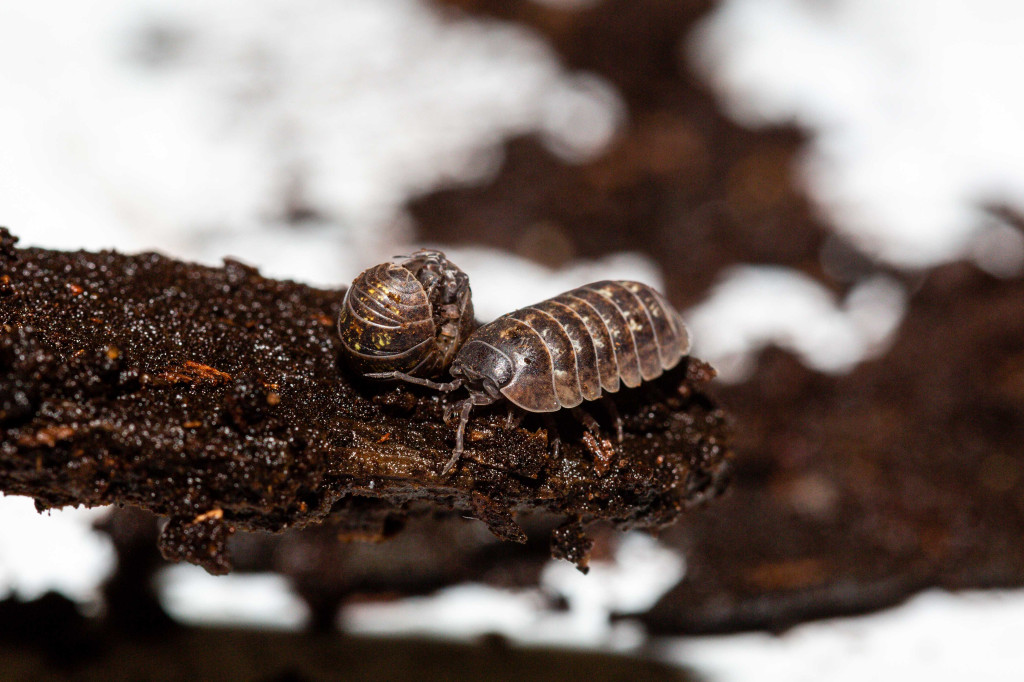
By Julie Geiser
Everyone has seen a roly-poly bug. Their ability to tuck into a little ball, called conglobation, has amazed children and adults alike. But what exactly is a roly-poly bug, and what is its purpose in nature?
The roly-poly bug is sometimes called woodlouse or wood shrimp, but its official name is pillbug or Armadillidium vulgare. The pillbug is an isopod; iso- means same or equal and pod means foot. Actually, the pillbug isn’t a bug at all. They are terrestrial crustaceans and closely related to shrimp, crabs and crayfish, and they have adapted to live entirely on land.
Pillbugs are most active at night and breathe through gill-like structures that require moisture, which is why we see them in moist environments in soil, under logs, leaves and other decomposing vegetation. Although they need humid environments, they cannot survive underwater.
Roly-polies range in size but average from ¼ to ½ inches long. Their body parts include a head, thorax and abdomen. The head consists of jaw-legs that pass food to the mouthparts and two compound eyes. The leg-bearing thorax consists of seven hardened plates resembling an armadillo.
Their gray to brown color keeps them camouflaged from predators, such as birds, lizards, frogs and spiders, and when rolled into a ball, strong body plates make it difficult for predators to get to their soft underside. Pillbugs also produce unpleasant secretions, which repel potential predators.
Unlike other crustaceans, isopods have unstalked compound eyes on their head instead of eyes at the end of a stalk that are attached to the head. They have two antennae with sensory setae, or stiff hairs, attached to them along with a smaller pair of antennules; both are used to find food and detect scented chemicals called pheromones produced by other pillbugs. This is how they locate other pillbugs and suitable habitats to feed.
Males and females can be distinguished by their undersides. Females have a brood pouch called a marsupium on their underside where fertilized eggs are incubated and hatched after three to seven weeks. Broods can range from seven to 200 eggs, and females may have one to three broods a year, typically during warmer months. The young survive on nutrients received through marsupial fluid from their mother. Newly hatched young may stay in the pouch around 6 to 12 weeks before venturing out on their own. Developing young that have left the pouch are called mancas. Mancas molt several times to gain the seventh segment of their body, their seventh pair of legs and a hardened exoskeleton. Pillbugs molt throughout their lifetime, which can occur every two to five years.
Pillbugs are scavengers and decomposers. They eat decaying matter from dead plants and animals, along with other decomposing materials, and return essential nutrients back into the soil. They even eat their own feces. When they poop, pillbugs lose copper, an essential element they need to survive. Therefore, pillbugs help to rid soil of heavy metals by taking in copper, zinc, lead, arsenic and cadmium. Pillbugs can live in contaminated soils where other species can’t, and they have a positive impact on the ecosystem as they increase mineral layer nutrients consisting of nitrogen, phosphorous and potassium. They also eat fungal matter that, if left alone, would increase carbon dioxide being released into the atmosphere.
Pillbugs are sensitive to environmental changes and thus serve as biological indicators for the health of the ecosystems where they are found.
Finally, roly-polies don’t bite or sting and pose no risk to humans. They rarely eat living plants or crops in agricultural lands. If they do venture into your home, they cannot survive for more than a few days unless they find humid conditions to live. These creatures simply provide their services to the ecosystem and give us all the pleasure of watching them transform into little balls.
